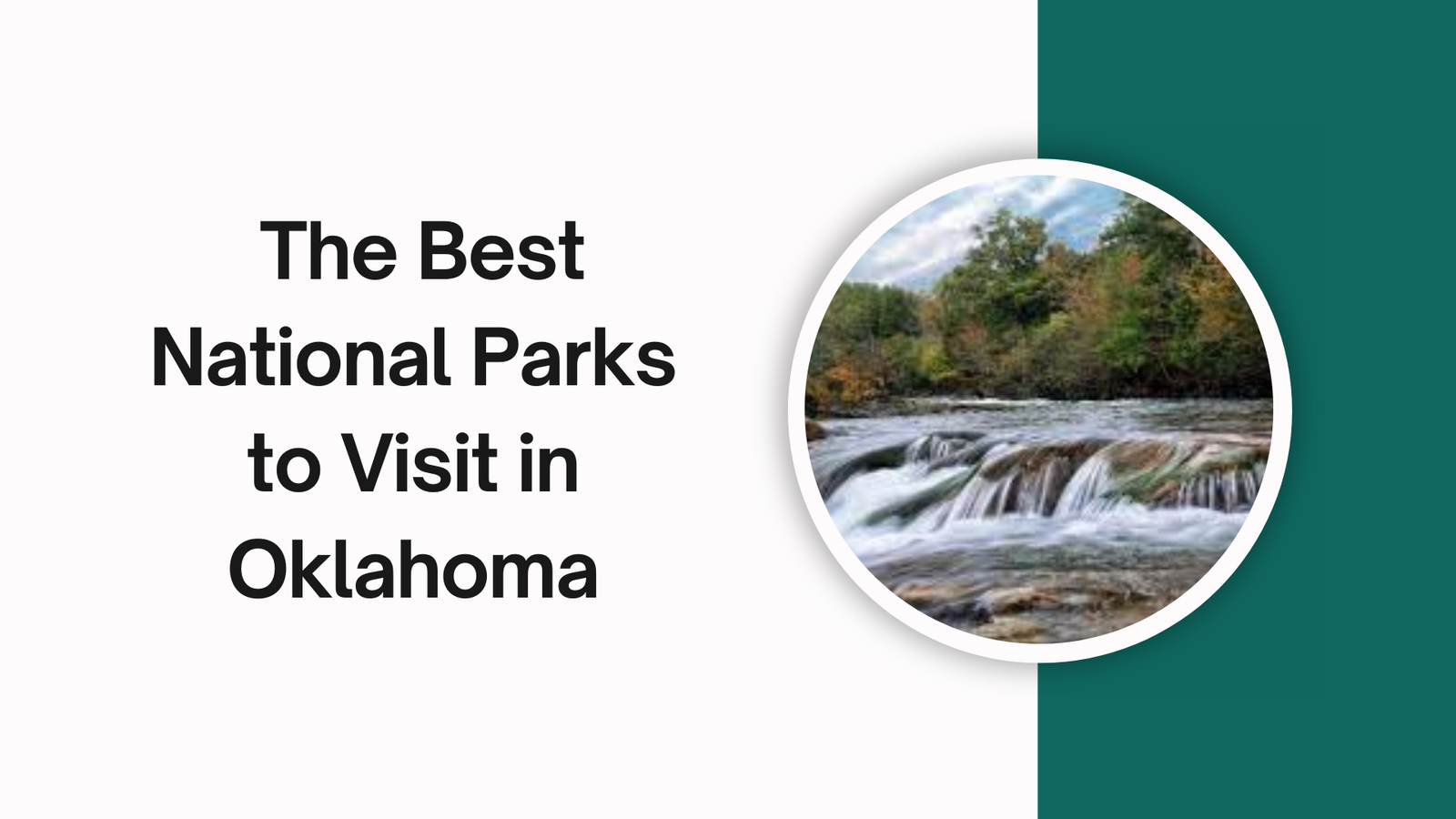
Oklahoma offers a diverse array of national parks, historic sites, and recreational areas that highlight its unique landscapes, rich history, and vibrant natural beauty. From ancient mountains to vast plains, Oklahoma’s national parks and monuments provide endless opportunities for exploration and outdoor adventure. In this guide, we’ll explore some of the best national parks to visit in Oklahoma, each offering a distinct experience for nature lovers, history buffs, and families alike.
1. Chickasaw National Recreation Area
Highlights:
- Location: South-central Oklahoma, near Sulphur
- Top Attractions: Little Niagara Falls, Travertine Creek, Lake of the Arbuckles
- Best Time to Visit: Spring and fall for mild weather and stunning scenery
Chickasaw National Recreation Area, often called the “Oasis in the Oklahoma Prairie,” is a haven for outdoor enthusiasts. Established to protect the area’s mineral springs, the park combines natural beauty with recreational opportunities. The Travertine Creek area, with its crystal-clear water and mini waterfalls like Little Niagara, is perfect for swimming and picnicking during the warmer months. The mineral springs, known for their healing properties, were once a popular destination for Native Americans and early settlers.
The park also features the Lake of the Arbuckles, a popular spot for boating, fishing, and kayaking. Surrounding the lake and creek are scenic trails, including the Bromide Hill trail, which leads to an overlook with stunning views of the park and the Arbuckle Mountains. Whether you’re hiking, camping, or simply relaxing by the water, Chickasaw National Recreation Area offers a serene escape into Oklahoma’s natural landscapes.
2. Washita Battlefield National Historic Site
Highlights:
- Location: Near Cheyenne, western Oklahoma
- Top Attractions: Interpretive trails, visitor center exhibits, historic battlefield
- Best Time to Visit: Spring and fall for comfortable weather and scenic views
Washita Battlefield National Historic Site commemorates the tragic Battle of Washita, a significant conflict between the U.S. Army and Cheyenne warriors led by Chief Black Kettle. In 1868, U.S. forces attacked the Cheyenne camp, marking a pivotal event in the Indian Wars and shaping the history of the Great Plains. The site preserves this important part of Oklahoma’s history and serves as a memorial to those who lost their lives.
Visitors can explore the battlefield via an interpretive trail, with signs that provide historical context and details about the battle. The park’s visitor center offers exhibits, a short film, and artifacts that provide insights into the complex relationship between Native Americans and U.S. settlers. The site encourages reflection and provides an educational experience for those interested in learning more about Oklahoma’s role in Native American history and the impact of westward expansion.
3. Oklahoma City National Memorial & Museum
Highlights:
- Location: Oklahoma City, central Oklahoma
- Top Attractions: The Reflecting Pool, Survivor Tree, Field of Empty Chairs
- Best Time to Visit: Year-round; spring and fall for outdoor visits
The Oklahoma City National Memorial honors the victims, survivors, and heroes of the 1995 bombing of the Alfred P. Murrah Federal Building. This deeply moving site is dedicated to remembrance and healing, featuring a series of powerful outdoor memorials and an adjacent museum.
Visitors are often drawn to the Reflecting Pool, which stretches through the site, and the Field of Empty Chairs, where each chair represents one of the 168 lives lost. The Survivor Tree, an American elm that survived the blast, stands as a symbol of resilience. The museum offers exhibits detailing the events surrounding the tragedy, the lives of those affected, and the impact of the attack on Oklahoma City and the nation.
For those looking to pay tribute or gain a deeper understanding of this moment in history, the Oklahoma City National Memorial is a place of both education and reflection.
4. Wichita Mountains Wildlife Refuge
Highlights:
- Location: Southwestern Oklahoma, near Lawton
- Top Attractions: Mount Scott, wildlife viewing, Quanah Parker Lake
- Best Time to Visit: Spring and fall for mild weather and optimal wildlife sightings
Wichita Mountains Wildlife Refuge is one of Oklahoma’s most scenic destinations, covering over 59,000 acres of rugged terrain, rolling grasslands, and granite mountains. This refuge, established in 1901, is home to diverse wildlife, including American bison, elk, prairie dogs, and longhorn cattle. It provides an excellent opportunity for wildlife enthusiasts and photographers to observe these animals in their natural habitats.
One of the park’s most popular activities is hiking to the top of Mount Scott, which offers panoramic views of the refuge and surrounding plains. Visitors can also enjoy rock climbing, fishing, and camping in designated areas. Quanah Parker Lake, named after the famous Comanche leader, is a great spot for fishing, kayaking, or enjoying a peaceful picnic.
For families, the refuge offers guided tours and educational programs about the region’s history, geology, and wildlife conservation efforts. With its stunning landscapes and abundant wildlife, Wichita Mountains Wildlife Refuge is a favorite destination for outdoor adventurers and nature lovers.
5. Fort Smith National Historic Site
Highlights:
- Location: On the Oklahoma-Arkansas border
- Top Attractions: Historic courthouse, jail, Gallows Hill, interpretive exhibits
- Best Time to Visit: Spring and fall for comfortable weather and special events
While technically located in Arkansas, Fort Smith National Historic Site extends into Oklahoma and has strong ties to Oklahoma’s history, making it a popular destination for Oklahoma travelers. Fort Smith played a key role in the administration of justice in the Indian Territory, housing the famous “Hanging Judge” Isaac Parker’s courthouse and jail. Parker presided over a turbulent period when Fort Smith was the last federal outpost before the vast, lawless Indian Territory.
Visitors can explore the historic courthouse, visit the jail where outlaws were held, and learn about the federal marshals who attempted to bring order to the region. Gallows Hill, where many convicted criminals met their fate, provides a sobering reminder of the challenges faced by law enforcement in the Old West. The park’s visitor center offers exhibits and films that detail the history of Fort Smith and its role in frontier justice, making it an intriguing stop for history buffs.
6. Trail of Tears National Historic Trail
Highlights:
- Location: Crosses through eastern Oklahoma
- Top Attractions: Historic sites, interpretive trails, museums, and memorials
- Best Time to Visit: Spring and fall for mild weather and scenic landscapes
The Trail of Tears National Historic Trail commemorates the forced relocation of Native American tribes from the southeastern United States to designated Indian Territory, including what is now eastern Oklahoma. This trail serves as a poignant reminder of the hardships endured by the Cherokee, Choctaw, Muscogee (Creek), Chickasaw, and Seminole peoples during their journey westward in the 1830s.
Several stops along the trail in Oklahoma feature interpretive markers, exhibits, and memorials that honor the resilience of these tribes. Sites like the Cherokee Heritage Center in Tahlequah and the Muscogee (Creek) Nation Capitol in Okmulgee offer further insights into the history and culture of Native Americans in Oklahoma. The Trail of Tears National Historic Trail is a meaningful journey through both Oklahoma’s landscape and its history, allowing visitors to reflect on a pivotal and challenging chapter in American history.
7. Salt Plains National Wildlife Refuge
Highlights:
- Location: North-central Oklahoma
- Top Attractions: Salt flats, unique selenite crystal digging, birdwatching, wildlife viewing
- Best Time to Visit: Spring and fall for bird migrations and cooler temperatures
Salt Plains National Wildlife Refuge is one of Oklahoma’s most unique natural attractions. The refuge is home to salt flats that cover thousands of acres, creating a surreal, otherworldly landscape. It’s the only place in the world where visitors can dig for hourglass-shaped selenite crystals, a rare form of gypsum unique to this area.
Birdwatching is another popular activity at Salt Plains, especially during the spring and fall migrations when thousands of birds, including endangered species, make their way through the refuge. In addition to birds, the refuge is home to a variety of wildlife, including bison, deer, and bobcats.
Whether you’re interested in crystal digging, wildlife viewing, or simply experiencing the unusual salt flats, Salt Plains National Wildlife Refuge is a must-see destination in Oklahoma’s north-central region.
Final Thoughts
Oklahoma’s national parks offer an impressive variety of experiences, from hiking rugged mountains to exploring historical battlefields and unique geological formations. Each park tells its own story, preserving the natural beauty and cultural heritage that make Oklahoma such a fascinating place to visit. Whether you’re interested in outdoor recreation, historical exploration, or simply soaking up the scenic landscapes, these national parks offer unforgettable experiences for every traveler.
